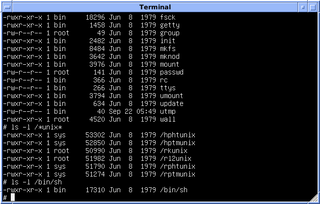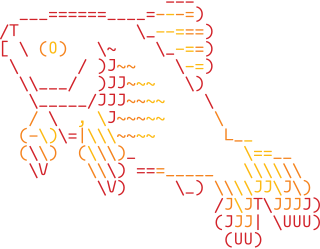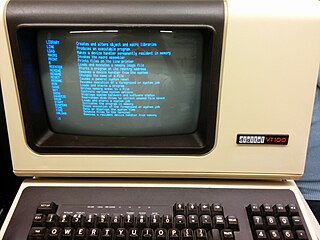
Bash is a Unix shell and command language written by Brian Fox for the GNU Project as a free software replacement for the Bourne shell. First released in 1989, it has been used as the default login shell for most Linux distributions. Bash was one of the first programs Linus Torvalds ported to Linux, alongside GCC. A version is also available for Windows 10 and Windows 11 via the Windows Subsystem for Linux. It is also the default user shell in Solaris 11. Bash was also the default shell in versions of Apple macOS from 10.3 to 10.15, which changed the default shell to zsh, although Bash remains available as an alternative shell.

A Unix shell is a command-line interpreter or shell that provides a command line user interface for Unix-like operating systems. The shell is both an interactive command language and a scripting language, and is used by the operating system to control the execution of the system using shell scripts.

The Bourne shell (sh) is a shell command-line interpreter for computer operating systems.

In Unix-like and some other operating systems, the pwd command writes the full pathname of the current working directory to the standard output.

In computing, a fork bomb is a denial-of-service attack wherein a process continually replicates itself to deplete available system resources, slowing down or crashing the system due to resource starvation.

In computing, time is a command in Unix and Unix-like operating systems. It is used to determine the duration of execution of a particular command.
In computing, echo is a command that outputs the strings that are passed to it as arguments. It is a command available in various operating system shells and typically used in shell scripts and batch files to output status text to the screen or a computer file, or as a source part of a pipeline.
In computing, kill is a command that is used in several popular operating systems to send signals to running processes.
nohup is a POSIX command which means "no hang up". Its purpose is to execute a command such that it ignores the HUP (hangup) signal and therefore does not stop when the user logs out.
On POSIX-compliant platforms, SIGHUP is a signal sent to a process when its controlling terminal is closed. It was originally designed to notify the process of a serial line drop. SIGHUP is a symbolic constant defined in the header file signal.h.

fish is a Unix shell with a focus on interactivity and usability. Fish is designed to give the user features by default, rather than by configuration. Fish is considered an exotic shell since it does not rigorously adhere to POSIX shell standards, at the discretion of the maintainers.
In computing, a shell builtin is a command or a function, called from a shell, that is executed directly in the shell itself, instead of an external executable program which the shell would load and execute.
In Unix shells, wait is a command which pauses until execution of a background process has ended.
In Unix and Unix-like operating systems, job control refers to control of jobs by a shell, especially interactively, where a "job" is a shell's representation for a process group. Basic job control features are the suspending, resuming, or terminating of all processes in the job/process group; more advanced features can be performed by sending signals to the job. Job control is of particular interest in Unix due to its multiprocessing, and should be distinguished from job control generally, which is frequently applied to sequential execution.

In Unix and Unix-like operating systems, type is a command that describes how its arguments would be interpreted if used as command names.
In computing, pushd and popd are commands used to work with the command line directory stack. They are available on command-line interpreters such as 4DOS, Bash, C shell, tcsh, Hamilton C shell, KornShell, cmd.exe, and PowerShell for operating systems such as Windows and Unix-like systems.

In computing, help is a command in various command line shells such as COMMAND.COM, cmd.exe, Bash, qshell, 4DOS/4NT, Windows PowerShell, Singularity shell, Python, MATLAB and GNU Octave. It provides online information about available commands and the shell environment.
In a Unix shell, the full stop called the dot command (.) is a command that evaluates commands in a computer file in the current execution context. In the C shell, a similar functionality is provided as the source command, and this name is seen in "extended" POSIX shells as well.
The restricted shell is a Unix shell that restricts some of the capabilities available to an interactive user session, or to a shell script, running within it. It is intended to provide an additional layer of security, but is insufficient to allow execution of entirely untrusted software. A restricted mode operation is found in the original Bourne shell and its later counterpart Bash, and in the KornShell. In some cases a restricted shell is used in conjunction with a chroot jail, in a further attempt to limit access to the system as a whole.
On Unix-like computer systems, seq is a utility for generating a sequence of numbers.








